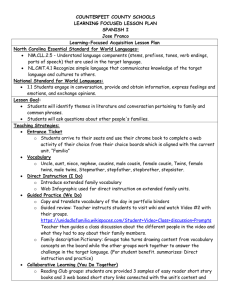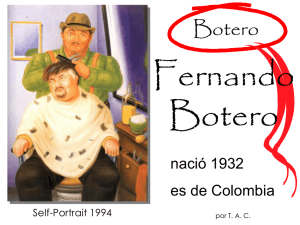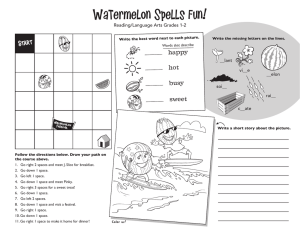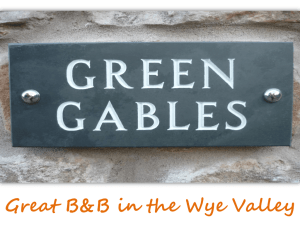Densifying the Suburbs: A Single-Family Home Alternative for
advertisement
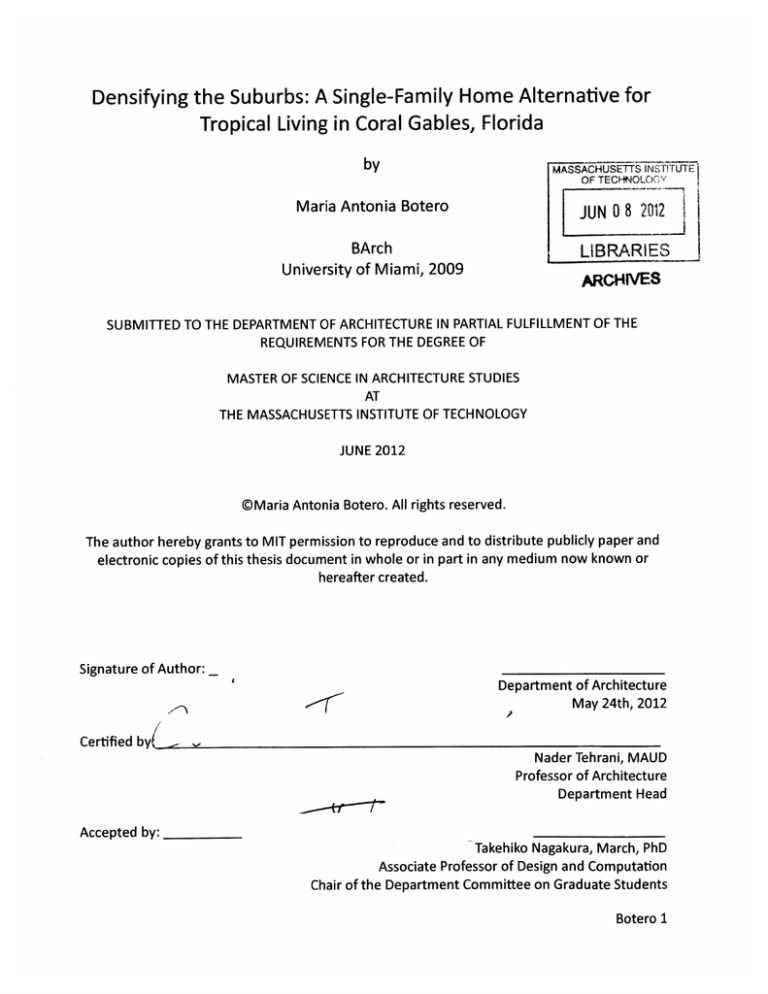
Densifying the Suburbs: A Single-Family Home Alternative for Tropical Living in Coral Gables, Florida by MASSACHUSETTS INSTITUTE OF TECHNOLOG'Y Maria Antonia Botero JUN 0 8 2012 BArch University of Miami, 2009 LIBRARIES ARCHIVES SUBMITTED TO THE DEPARTMENT OF ARCHITECTURE IN PARTIAL FULFILLMENT OF THE REQUIREMENTS FOR THE DEGREE OF MASTER OF SCIENCE IN ARCHITECTURE STUDIES AT THE MASSACHUSETTS INSTITUTE OF TECHNOLOGY JUNE 2012 @Maria Antonia Botero. All rights reserved. The author hereby grants to MIT permission to reproduce and to distribute publicly paper and electronic copies of this thesis document in whole or in part in any medium now known or hereafter created. Signature of Author: _ Department of Architecture May 24th, 2012 Certified by( Nader Tehrani, MAUD Professor of Architecture Department Head Accepted by: Takehiko Nagakura, March, PhD Associate Professor of Design and Computation Chair of the Department Committee on Graduate Students Botero 1 Thesis Commitee Advisor: Nader Tehrani, MAUD Professor of Architecture Department Head Reader: Michael Dennis, BArch Professor of Architecture Botero 3 Densifying the Suburbs: A Single-Family Home Alternative for Tropical Living in Coral Gables, Florida by Maria Antonia Botero Submitted to the Department of Architecture on May 24th, 2012 in Partial Fulfillment of the Requirements for the Degree of the Master of Science in Architecture Studies ABSTRACT This design project was an experimental case study to establish a viable, reducedsize typological alternative for single-family housing as a potential vehicle for the densification of the urban suburbs. Through demographic and census data, the need for this kind of densification was first established and then a design project was formulated using site-specific parameters and industry projections on the future of housing needs. The project began with a study of different housing typologies that variably affected urban form. Then, the project focus narrowed to a complete design proposal for the selected site where specific typological ideas and their resulting urban form were tested. Thesis Supervisor: Nader Tehrani Title: Professor of Architecture & Department Head Botero 5 TABLE OF CONTENTS TITLE PAGE 1 THESIS COMMITEE 3 ABSTRACT 5 TABLE OF CONTENTS 7 INTRODUCTION 9 EXISTING CONDITIONS Demographics Geography and History Taxonomy of Existing types 13 15 17 21 TYPOLOGICAL EXPLORATIONS Infill Method "Parasite" Method Fabric "Mat" Method Hyper-Aggregared "Mat" 31 35 43 49 55 THE PROJECT The Proposal The Typology The Raised Porch and the Green Spaces Mixed-Use and Multi-Use Spaces The Change of the Existing Street 61 63 69 74 81 85 Botero 7 .0 1975 OVIP 6lb\ dell, 1980 1985 Distribution of Owner-Occupied Housing Units Across Metropolitan Statistical Area Locations 1995 2000 2005 2010 >_ 1000 1500 2000 2500 SIZE IN FT2 Housing size chart showing size reduction in 2009 Illustration of the urban suburbs of the Metropolitan Miami area (in red) in relationship to the city center (in white). INTRODUCTION The majority of the U.S. population lives in energy costs down, tightening credit standards the "urban suburbs" within metropolitan and less emphasis on purchasing a home purely "urban for investment purposes, which point to this suburbs" are the area immediately adjacent size-reduction as a more permanent tendency.23 statistical areas (MSA).' These to the most dense city centers, and are mostly commonly comprised of single family homes. Aside from demographic housing changes size trends, and recent advances in In 2009, there was a major change in the trend of technology have changed the way we live growing single-family home sizes and although and have expanded it may be a "recession-related phenomenon," the way we design and build our homes. there are other factors like the desire to keep 2 Dietz 1Dietz and Siniavskaia, Ph.D. 2011 the possibilities for and Siniavskaia, Ph.D. 2011 3 Emrath, Ph.D and Siniavskaia, Ph.D. 2009 Botero 9 sons or More Distribution of Home Owners by Household Size Within Urban Suburbs NO E National Average of Square Feet per Person for Single-Family Homes According to the 2010 census, most people Despite that families have no longer live in nuclear families. About 90% numerous and that people need less living of single-family households are comprised space, housing sizes have not decreased of four or less people and more than half enough to reflect these changes. In MSAs, not of those households are only made up of including the city centers, the average amount one or two people, suggesting that most of space per person is currently 800ft.s people are either living alone with a partner or spouse or are single parents.4 This means that the greatest need in the future of housing is mostly for one or two-person households and reduced yet still significant for three and at most four-person homes. 4 Dietz and Siniavskaia, Ph.D. 2011 become less According to a 2010 survey on housing trends andsizes, builders, architects and manufacturers indicated that they expect the average, singlefamily home of the near future to be smaller. The survey results provide detailed information regarding housing design trends that reflect s Dietz and Siniavskaia, Ph.D. 2011 Great Room (Kitchen - FR - LR) Walk-in Closet in Master Bedroom Laundry Room Ceiling Fan Master Bedroom on 1st Floor in 2-st. Home 2-car Garage 9+ Ceiling Height in First Floor Home Office Indoor Fireplace Bolder Colors on Interior Walls Three Bathrooms or More Mudroom Unheated (3-season) Porch Dining Room Skylights 3+ Car Garage Four Bedrooms or More Living Room Media Room Hobbies Room Sunroom Two Master Bedroom Suites I 0 I 1 I1 - 2 3 1 4 I 5 Rooms/Features liekly to be included in Average, New Single-Family Detached Home in 2015 (1 = Not at all likely, 5 = Very likely) Survey results from "The New Home in 2015" survey qtd. in Quint, 2011. Highlighted in the chart are the most significant changes in trend that affect the total size of the home. some of the economic and demographic Although the data available can help identify conditions we currently live in, like the reduced the average number of people per household need for room like the living room and the and the spaces they require to live according dining room and an overall reduction in size to current conditions, none of these studies and number of bedrooms. 6 Since the survey focus on the actual design of these required is limited to pointing out the need for certain living spaces in light of the way in which living spaces it provides an objective starting we actually live. The aim of this project is point for the redesign of a more appropriate to propose a new urban typology for city dwelling by enumerating expected housing growth, based on new living space design requirements according to housing trends. and in tune with the suggested herewith. 6 Quint 2011 Botero 11 SOURCES Dietz, Robert, and Natalia Siniavskaia, Ph.D. ""The Geography of Home Size and Occupancy"." Housing Economics. December 1, 2011. www.housingeconomics.com (accessed January 5, 2012). Emrath, Ph.D., Paul, and Natalia Siniavskaia, Ph.D. ""Household type, Housing Choice and Commuting Behavior"." Housing Economics. December 7, 2009. www.housingeconomics.com (accessed January 5, 2012). Quint, Rose. "Special Study for Housing Economics." Housing Economics. March 2011. www. housingeconomics.com (accessed January 5, 2012). EXISTING CONDITIONS Botero 13 Illustrated historical postcard showing one of the winding canals through Coral Gables Image source: University of Miami Florida Postcard Collection@ Demographics Coral Gables is a city of 46,780 people, the this growth, Coral Gables' historical areas majority (53%) of whom consider themselves have remained untouched. The majority of white (40%) or white Hispanic (53%). Only the physical growth has taken place near the 17.9% of people are under 18 years of age commercial downtown area and in the areas and 15.6% are over 65. This means that zoned for residential, high-density multi-family the majority of the people in Coral Gables residential use. The per capita ($53,264) and are young professionals or starting families median ($84,027) income are both twice that (University of Miami students are not counted of Florida ($26,551 and $47,661 respectively) as residents.) Since 2000, the city's population and the University of Miami isthe city's biggest has grown 10.7%, in line with the Metropolitan employer. The city's total area is 12.9 square Miami population growth of 10.2%. Despite miles and the population density is relatively Botero 15 Coral Gables highlighted in Dade-Country (highlighted in Florida above) Image source: Wikimedia Commons Free License low at 3,621 people/mi 2 (compared to 11,135 than that of metropolitan Miami (58%) but still 2 more than twice the national average.3 These ppl/mi 2 for Miami Metro and 11,510 ppl/mi figures speak to Miami's standing as a main for the city of Miami Beach.) 1 According to the U.S. Census Bureau predictions, about 70% of the population increase in the United States is attributed to immigration, with the national percentage of foreign-born residents quickly approaching 13%.2 In Coral Gables, 30.6% of the population is foreign-born, which is considerably lower arrival point for Latin American immigrants, due in part to its proximity to Central and South America. Despite these figures and the fact that there are numerous local communities that identify with specific immigrant groups, there are very few areas close to the city center that cater specifically to newly-arrived and local young professionals and families. 1 Census 2012 2 Capps, et al. 2005 3 Census 2012 Historical photographs of Coral Gables city Hall (left) and the fire station (right) Image source: Florida Department of State Division of Historical Resources @ Geography and History Coral Gables was first established by George The original inspiration for the city was Merrick during Miami's 1920's land boom after Frederick Law Olmstead's work for Central he expanded his father's 160-acre plantation Park following the "City Beautiful Movement;" to around 3,000 acres and formulated a which promoted the use of tree-lined avenues, development project for the area at an winding roadways, green open spaces and unprecedented scale. Merrick's ambition was ornate plazas and in the case of Coral Gables, mostly fueled by Miami's tropical climate the architecture was entirely formulated to and extensive shoreline, which he believed were the most appropriate backdrop for the follow the Mediterranean Revival style. These development of city that spoke of the area's notoriously strict building and zoning code rich Spanish heritage.4 for the city, which has yielded a mostly lushly- basic design stipulations set the stage for a planted, suburban neighborhood. I Steig (n.d.) 5 Steig (n.d.) Botero 17 Typical tree-lined street of Coral Gables Image source: "ATale of Two Villages" blog by Manuel Delgadillo@ Modern-day Coral Gables is surrounded by 3 7 th Avenue major urban arteries that make up an essential and on the South by the Charles Deering Estate. part of the metropolitan Miami street grid. The city is located within a 15-minute drive of These major streets clearly demarcate the Miami's downtown and financial district and city bounds of Coral Gables and provide direct about a 10-minute drive from the airport; beach connections from the city to other significant access either to South Beach or Key Biscayne urban centers within the metropolitan Miami is within a 25-minute drive. Despite that there area, as well as direct access to the highways. are several bus stops on the main arteries that Coral Gables in bordered on the West by border Coral Gables and that the metro-rail 5 7 th (Douglas Road) north of 2 6 th Street; Avenue (Red Road) north of 7 2nd Street (Sunset runs along U.S. route 1, the frequency of trips Drive); on the West by and stops of both the buses and the train is not 4 9 th Avenue and Old Cutler Road; on the North by SW 8 th Street significant to make public transportation easily (Calle Ocho or Tamiami Trail); on the East by available. sources Bureau, U.S. Census. Coral Gables (city) QuickFacts from the US Census Bureau. January 23, 2012. http:f/ quickfacts.census.gov (accessed February 28, 2012). Capps, Randy, Michael Fix, Julie Murray, Jason Ost, Jeffrey S. Passel, and Shinta Shinta Herwantoro. "The New Demography of America's Schools: Immigration and the No Child Left Behind Act." Quint, Rose. "Special Study for Housing Economics." Housing Economics. March 2011. www. housingeconomics.com (accessed January 5, 2012). Steig, Stacy. "A History of Coral Gables: A look into the past." Metro Magazine, n.d. Botero 19 1.SEGOVIA AND MALAGA Total Area: 146,971 ft2 Total Square footage: 42,140 ft2 FAR: 0.28 2 Coverage: 35,968 ft (24.4%) Empty Area: 11 1,003ft2 (75.6%) Estimated Number of Residents (one person / 800 ft"): 52.6 2. MIXED BLOCK NEAR ALHAMBRA 2 Total Area: 172,178 ft Total Square footage: 75,122 ft2 FAR: 0.43 Coverage: 48,748 ft2 (28.3%) Empty Area: 123,430 ft2 (71.7%) Estimated Number of Residents (one person / 800 ft2): 93.9 3.21stand27th Total Area: 175,635 ft 2 Total Square footage: 67,270 ft2 FAR: 0.38 Coverage: 53,492 ft2 (30.4%) Empty Area: 122,143 ft2 (69.6%) Estimated Number of Residents (one person / 800 ft 2 ):84 4. MALAGA AND LEJEUNE Total Area: 147,816 ft 2 Total Square footage: 80,838 ft2 FAR: 0.54 Coverage: 42,161 ft 2 (28.5%) Empty Area: 105,655 ft2 (71.5%) Estimated Number of Residents (one person / 800 ft2): 101 5. LARGE HOUSING BLOCK ON ALHAMBRA Total Area: 173,397 ft2 Total Square footage: 247,019 ft2 FAR: 1.42 Coverage: 107,034 ft2 (61.7%) Empty Area: 66,363 ft2 (38.3%) Estimated Number of Residents (one person / 800 ft2): 308.7 Botero 21 TWO -STORYAMUW-FAMLYBUILD M .... SEGOVI ANDAMLA TolI ~ %8 f 24446W ~ ~ Tot.1 cOv~q,4210 Sq 1 ooo DErAcHEDSMOLE-FMULTHOtW --- - 'O-STOYMLILTJAMILYUAD#EG .. LOW.WMULAMMYcO - MD SIMUGEEM Y ....--. ADnom .......... SWOLE-.OOR MUL1-FA*WHOME HOME u MIMOOCK NMRALHAMMA TotalArea:1721 fbt TotalSarefootlg: 75,122ft FAR:.43 C OVerage: 48,748ft' (28,3% FlptyArea123,4300t 71.7%) Numberof Reldents (oniepeson / 800ft' Estimated ) PpLt 93.9 5,2D3 Botero 23 SWGLE-FWO MULJ1-FAARLrHOWE ...... 21 .. nd2?a~ONE LOCK T7 At, I 7V, ~3 492 A,, 122141 11' Wt (30 4 DffACHfED SNGLEJiALYHOME * . OrHEN-N"-AWUNfT $1 lhiu.-~ a. MAIL- MOW~ DALITT-FAY ~SINCAMFOOA * D~DETA#DSWUdGL-AMY~HOWE m ..... a-ISCN TW06STONAIMULI-AMIYEWIMDING ANDLWJUN MALAGA vs T010Sqssss f-q, 8S3F Ift so~q42,161 205 Asfe 105,65 Wt57,5-I Empty 1tFoN -,,0,f R,d,,T,,WPpI'(nil 19 5 ',5800FF0 11 Botero 25 f ,** AD** *- Momsw ......... TWO-STOffyAWTI-FAWLY#UffDUEG LOW EhOUWMKLOCKONALHAMA ToaSu efoa 247 Cowge107034hfT 511' nil 49, 632 TYPEONE 1. Detached Single-Family Home with: - Additions Mother-in-Law Unit LI E LL 17 TYPE TWO 2. Single-Floor Multi-Family Home -Additions -Mirrored 44, ER ].uzz LIZ TYPE THREE 3.Two-Story Multi-Family Building -Two buildings on one plad -Additions -Mirrored El ETh LII Botero 27 TYPE FOUR 4. Low-Rise Multi-Family Condo -Multiple Owners who own one piece of land TYPE FIVE 5. Mid-Rise Condo -Mirrored -L-shape organization EXISTING HOUSING TYPES 1.Detached Single-Family Home 2.Single-Floor Multi-Family Home 3.Two-Story Multi-Family Building 4. Low-Rise Multi-Family Condo 5.Mid-Rise Condo Botero 29 TYPOLOGICAL EXPLORATIONS Botero 31 The studies collected in this publication explore area of 400 ft 2 per person. Though each possible typological variations applied to urban form, from aggregation held density as its primary motivator, Each each explored different approaches to achieve iteration aggregates the housing units in different that density within established parameters. This combinations, while restricting size parameters. exploration produced very different typological The exploration sought an aggregation method and results, each of which was then examined for typology that best promotes both the creation of feasibility. small public spaces to larger morphologies. public spaces and the possibility for neighborhood growth. While the project aims to increase density of an existing residential neighborhood, increased density alone falls short of the potential for urban design intervention in such areas. Ultimately, this study found that the most desirable typologies preserved the existing character of the neighborhood while simultaneously opening its urban fabric to possibilities for new growth. Typologies that preferenced lower building heights, The ideal typology sought in the study will be easily smaller footprints, and designated open spaces aggregated from component housing units, allow proved most successful in acting as a joint between for mixed uses, and respond to the South Floridian the existing fabric and new, denser infill housing. tropical climate, without exceeding a conditioned Botero 33 INFILL METHOD USING A SINGLE-WIDE TYPOLOGY This method focuses on inserting thin building throughout the existing fabric, creating a variety of private and public open spaces. The main organization force behind this strategy was the creation of adequate open space. r' REMOVE ADDITIONS* NM y ,ON* p MAINTAIN SUBACU i r ---------------------------- ww"M ALL * -.Y- - ............ ......... .......... ----------- ~EL~I OPENSPAC. * - - - ** Urban strategies INTRODUCTIONOF AN ALLEY EXISTINGSTREETHIERARCHY Y~AST~AET 11010"01" ~O~XAI< YOi4~ATY~A~AX .. . ........... I EXISTINGHOUSING DENSITY ~ T ~ATA~ A*XYT~A~Y4- A SHIFTIN HOUSINGDENSITY Morphological changes Botero 35 Massing diagrams of urban progression Core placement within the typology -----------:------------------. 1... XNOI Aggregation diagram A EXISTINGSECTION Section of existing condition I PROPOSED SECTION 6" 29' 26' Section of proposed condition 21.5 16' 16' 16 30 16' 29' '6' 242' Prototypical aggregation possibilities Botero 37 4* k 497 1# II 'I 12' 4' 16' 4' 12' 4' 16' 16 4 12 lo 00, 4' 12' 4' 16' 4' 12' Sectional possibilities along the proposed alley condition 12' 4' 4' 16' 16' 4' Schematic drawing of plan aggregations to create public space within the block Botero 39 Plan and view of proposed plan with trees Botero 41 "PARASITE" METHOD USING A COURTYARD TYPOLOGY This method focuses on using existing additions to main structures as the formal and physical support for a supplementary 'parasite' courtyard building that offers great potential for vertical growth. The main organizational force behind this experiment was the existing additions to the main structures and the preservation of privacy characteristic of the courtyard typology. 11,--- 1,-,, M No W" mrop 1b1a -W._ ~0 p 3 ~ fl ~L!~J ~ppji~i ~b ~Yil 1ph1' hb p~N El Urban strategies ftwl INTRODUCTIONOF AN ALLEY EXISTINGSTREFI HIERARCHY F EXISTINGHOUSING DENSITY SHIFT IN HOUSING DENSITY Morphological changes Botero 43 Massing diagrams of urban progression Core and circulation placement within the typology and aggregation diagram 4- p -t1 $91.O 141 Section of existing condition p <4 <4', 4- 6' U ~r Section of proposed condition Botero 45 - -il -4 p r-- I :. I 4i - '17 r LL r-r- Schematic drawing of plan aggregations to create public space within the block Botero 47 FABRIC "MAT" METHOD USING A ROWHOUSE TYPOLOGY This method focuses on introducing a brand-new typology and urban morphology to the area, using a low-rise, high-density approach that offers one of the highest density possibilities. The main organizational force behind this experiment was the provision of highly-structured private exterior spaces in lieu of community spaces. :L1 Vl OJ - --------st ee------i--e-----Urban MROSPP)~itN -------- ----- _-_--_-__-_--_-__-_--_-__-_--_-__-_--_-__-_--_-_ Urban strategies EXISTINGSTREETHIERARCHY EXISTINGHOUSING DENSITY INTRODUCTIONOF AN ALLEY SHIFTIN HOUSING DENSITY Morphological changes Botero 49 Massing diagrams of proposed 'urban mat' Core placement within the typology, ownership possibilities of middle massing and aggregation diagram Massing of two-house aggregation for the rowhouse typology Section of existing condition NO 6'I 28' 11.5'9.5' 11.5' 28' 25' 11.5' 9.5' 11.5' 29' 6' 242' Section of proposed condition Botero 51 -i """"""| ""-I --- 1 """"""" "" """""| r--"-"1 I"""-1 r-- -" I-I I---| ---- 4 I----I .-I -I ..... I ----. 4 ---- 4 Schematic drawing of plan aggregations to create private open space within the block r-41 I Botero 53 fABRIC "MAT" METHOD USING A HYPER-AGGREGATED COURTYARD TYPOLOGY This method focuses on the aggregation of courtyard typology in a manner that attempts to promote public space despite the typology's characteristic private nature. This method offers the highest density possibility out of all these experiments. The main organizational force behind this experiment was to provide the highest density possible while still maintaining adequate light and ventilation for the units towards the mid-block. low --- ---------- W itas a --------...--.. 7-- ----------------------------- -------10~~-TIA, --------------------,--------------------------------- ------ a 11VI j Urban strategies EXISTINGSTRIEETHIERIARCHY INTRODUCTIONOF AN ALLEY SHIFTIN HOUSING DENSITY EXISTINGHOUSING DENSITY Morphological changes Botero 55 Massing diagrams of proposed hyper-aggregated, mid-rise 'urban mat' Diagrams of possible aggregation methods Aggregation diagram and circulation core placement within the typology Section of existing condition iI i I I 7 /9 7 / el i 242' Section of proposed condition Botero 57 Schematic drawing of plan aggregations to create semi-private open space within the block Botero 59 THE PROJECT Botero 61 II ge wPP 11 hI AP I Ms di -WN 16., *-i- Ei nia r i .Am'm.. EV gosnsaine ir ... vaf . .o.. "16 die-~ sINIAN'dMs PE10l 1WM lu'... g td.I OIdiL.-..I *mi pM agg a Existing Site plan of selected neighborhood area of Coral Gables THE PROPOSAL This project is a case study that addresses The first and most apparent challenge in Coral several urban challenges in Coral Gables, Gables is the need for higher density in order Florida through the proposal of a new building to accommodate for an expected population typology. Despite the regional specificities increase. This is an intricate challenge since of urban architectural the increase in population means there will typology, the project is based on the premise also be a more diverse demographic expected of densification mostly through residential infill in the area. Ultimately, this will create a need and therefore, it provides guidelines for the for lower housing prices and higher rental densification of any urban suburb. The project availability. In light of the shift in family life in not only addresses the current challenges of the last 50 years, and the new need for more a growing population near metropolitan city affordable living spaces, the best solution centers, but also focuses on major lifestyle is to propose considerably smaller quality morphology and changes that have occurred in the last fifty homes to infill the urban suburbs rather than years and that have not been adequately inexpensively-built standard homes farther addressed in contemporary housing design. from the city center. The aim is to create a more Botero 63 IRMOP 0 0F 1111111111 Ia iIIoE ir J II N1111111 IVIRnqm sobki M RPA ri MJ111111 1646 a.uIt wuina in PI IN II Al411111191111 1.3' .m~q~&EPA '3. II 'a 0mdO 416"l1111WO E I 1 1111 Proposed block plan within existing site plan of selected neighborhood area diverse community that can accommodate response to this challenge is to create better the population increase and the demographic defined more refined legislative parameters for shift. Aside from providing a higher capacity the green spaces with more specific private, for residential buildings, the hope is to create semi-private and public functions within the a typology that can serve as small workshops, neighborhood blocks. The aim is to establish offices and in some cases as retail space. more This will allow the neighborhood to respond community can use in more accessible ways. significant green spaces that the financially as the population density increases. This will ensure that despite the reduction in The next challenge is to maintain the tree line and the availability of green open spaces, two of the most notable characteristics of Coral Gables. This challenge is at odds with the first green area, the new spaces will have more apparent and practical functions, giving them tangible community value, which will in turn, promote their success and longevity. challenge since an increase in built density will In order to respect the character of the tree inevitably impact the availability of unbuilt line, the majority of the density increase will be and thus provided green space. The best focused away from the existing neighborhood -- rn-i THEMID-BLOCK DICTATE DEVELOPMENTOF HIGH-DENSITY URBANCONDITONS TOWARDS TREES Diagram of proposed density areas within existing neighborhood fabric middle street morphology in order to urbanistically of the existing block, mostly in the large, respond to the density increase. This drastic unstructured areas that are currently oversized change takes the form of an alley that cuts streets and placed towards the backyards. With the intention of establishing the block parallel to its longer dimension. In and maintaining a strong urban edge, the this urban response, we begin to see the close proposed houses that face the existing street relationship between the new housing typology are built close to the existing sidewalk and and the resulting city morphology. The smaller, rise no more than twelve feet, preserving the single-wide house generates a density that swales beyond where the trees are planted. requires service from the city grid, prompting Since the mid-block area has the highest an extension of such grid into the existing block. proposed density, it requires a change in the Botero 65 Diagram ot existing street morphology Diagram of proposed street morphology, including tertiary alleys - IUM Axonometric of proposed block plan with arrow indicating through-alley m A Figure-Ground of Existing condition, showing an undefined urban edge and underdesigned green spaces IfP Figure-Ground of Proposed condition, showing a defined urban edge and regulated green spaces Axonometric Diagrams of block proposal showing progression from existing condition (top) to original buildings without additions (middle) on which the proposed scheme was planned (bottom). of creating a new urban through the prospect of live-work spaces and morphology, the alley offers a completely other small business establishments aligned new urban condition to the neighborhood. and serviced with these interior access routes. Since it is designed around the premise of The idea is that these multi-use spaces can a higher density, the alley can also offer the adjust to changing population size, economic As a result possibility of programmatic variety, which in conditions and turn, promotes greater community diversity demographic changes so that the neighborhood is more resilient. Botero 67 pp WI I fe I i'!3 All "ig I Proposed Site Plan 'K liii MAXIMUMFAR.FORFIRST5000sf. 49% 35% MAXIMUMFAR.FORNEXT500 s AREA. 48% MAXIMUMFAR.FORREMAININGNLOT ?-7700s. THISLOT:TO FAX 48041F5000s.1 -35%OFREMAOMNS Z700Lt COMBINEDFAA46%(3345 f. GROUNDCOVERAGE 35%MAXIMUM SIDESETBACKC 20%OFLOTWIDTH (MIN.15Lt ANDMAX:.20tH.) TWO-STOREY 29 ft MAXIMUM FRONT SETBACK: 25 ft MINIMUM ft REAR SETBACK 10ft. MINIMUM MIN.25 5t MIN 25N It SIDESETBACKft MINIMUM SETBACK: 5 ft.MINIMUM REAR Diagram of existing building code guidelines in Coral Gables and the typical resulting urban form The Typology Since the urban proposal is focused on the long, with some exceptions. These dimensions preservation of significant and systemic features are ideal for a single-wide house, like the (like green areas and the tree line) the new Florida vernacular types and it offers numerous housing typology is based on the dimensions dimensional of the available land surrounding the existing patterns, which can accommodate up to a Coral Gables homes. Because the city was built family of four in accordance to the maximum on strict setback parameters, the available need established using census data. These area surrounding existing homes is generally multiple possibilities in size and aggregation not variations and aggregation the same for most homes. This allows for the only allow for a variety of household sizes but design of a typology ranging from twelve to also for a diversity of uses and income levels. sixteen feet wide and twenty-five to forty feet Botero 69 -4 "'S MIN ' MAX.12' "S MIN. 12' MAX.16' Diagram of resulting dimensional parameters for the proposed typology AMPLE OVERHANG & SINGLE-WIDE INTERIOR Q : fD COVERED EXTERIOR LIVING SPACES Diagram of Florida typology highlighting its most significant characteristics Introduction of the core to the single-wide type and aggregation possibilities The traditional Florida types use overhangs costs, decreased moisture accumulation which and raised porches in order to provide exterior reduces the probability of cracked foundations living spaces, which allow the interior area and improved indoor air quality as a result of to remain small and more closely relate to decreased exposure to radon and other ground the tropical South Florida environment. In emitted toxicities. Typologically, the main addition to promoting exterior living through difference between the Florida vernacular types porch extensions, raising the building above and the contemporary home is the specific grade restores the effect of understructure allocation of space for indoor plumbing, which ventilation which provides a variety of practical the vernacular type did not take into account. and ecological benefits like lower cooling 26 82 .......... RL 0 (D) Above: One-bedroom house plan showing the separation of the public (yellow) and the private (blue) with the service core (red). Plan also shows the folding walls. Total 416ft2 residential. Right: Exploded axonometric of house, highlighting the "stacking core" The proposed type offers the benefits of the significant when the main focus is to keep the vernacular type, which include appropriate area of the house small without foregoing sun-shading and cross ventilation with the the necessary amenities of a contemporary added amenities of contemporary construction home. In addition to aiding in the resolution which include indoor plumbing and foldable of layout challenges, the core serves as a full exterior walls. The addition of a plumbing core service core that handles not only plumbing to the traditional single-wide type creates a but also electrical and mechanical equipment. supplementary architectural element that can This stacking method takes advantage of the be used to efficiently separate the private and type's ten to twelve-foot ceilings allowing public functions of the home, and in the cases on for the kitchen and bathroom areas to mixed-use dwellings,toseparatethecommercial occupy the first eight feet while equipment from the residential. The smart use of the core can be stored above, keeping unoccupiable as a layout-organizing element is especially area to a lean and cost effective minimum. Botero 71 SINGLE GLASS SLIDER FIXED LOUVER TILT AND TURN GLASS FIXED GLASS SINGLE LOUVER DOOR SLIDER FULL-SWING *1 *l. n A A COLLAPSIBLE NANA (LOUVER AND GLASS) WALL / / / / FULL-PIVOT PARTIAL-PIVOT Louver and glass door operability alternatives. These should be used as appropriate depending on specific programmatic and privacy constraints. The different options allow most walls to be completely collapsible or operable. First Floor Plan - 416t 2 of private space Above: Axonometric views of house highlighting decks and overhangs Right: One-bedroom house plan showing the relationship of typological elements like raised decks to community spaces (in green). Plans also show the folding walls. Total 723ft 2residential. Second Floor Plan - 307ft 2 of private space In addition to the interior features of the Again, we see the inextricable relationship house, the type is also significantly comprised between the architectural typology and the of exterior components that define space. The resulting city morphology since typological most important exterior elements are the porch elements like raised decks and overhangs also raised two feet above grade and the plentiful define community spaces, which determine overhangs, which span up to eight feet. Both an array of decisions that inevitably affect the of these elements along with the folding louver form and function of the urban realm. Most doors indoor/outdoor spaces that not only significantly, the proposed density increase, extendthe livingarea butalsoofferincreased sun the housing size decrease and the provision for protection for the house. They are also essential exterior living spaces-all aspects related to the privacy elements that reinforce the possibility typology-promote in concert agreater sense of of community spaces within the block since community and active citizenry by encouraging they offer a diversity of privacy alternatives. people's presence in the public realm. Botero 73 L 41 ~A a L 1 ............. illustrated plan of proposed houses and open spaces, showing through-path from existing street to alley The Raised Porch and the Green Spaces Beyond their architectural purpose, the raised zone between the private house walls and the porches are an essential systemic element of more public open spaces. In the inner-block the urban proposal as they define two main courtyard spaces, the raised porch serves as an types of green open spaces: the semi-private extension of the private indoor spaces. Then, yards and the reinterpretation of the more a series of design and privacy elements that public front yard. Within each of these two include screens, planters, operable sun-shading spaces, the porch serves different purposes; structures and the overhangs are used to however, in both cases, the raised decks act as further demarcate the space and determine the a privacy element, raising the entrance level level of privacy for each section of exterior deck of the adjacent homes and creating a buffer according to the interior functions of the house. Far Right: Axonometric diagram of proposed block scheme, highlighting the systemic nature of the raised deck network. Right: Section cut key Bottom: Cross Section of proposed scheme cutting through the new private courtyard and the reinterpreted front lawn. K i <ilL -~ W 0 -I 0 1 . . ........ .............................. J J k_ J G f 7I- $1 M!. L~ FE eju ~;i I- Existing property line condition (top,) compared to proposed condition (above) The design and use of the courtyard areas to the proposed structures. In any ownership can vary depending on their size and on the situation the courtyard areas provide a variety decisions of the residents immediately adjacent of possibilities that range from structured to them. The ownership of these areas can be community gardens to open lawns. These areas collective or single depending on the ownership can be gated and only accessible to the residents condition of the plot. The urban proposal of each specific plot, and despite that they are respects existing plot lines, giving existing land- always accessible from the main street and the owners various ownership choices that include alley, they are not visible from the public right single ownership of the land, a condominium of way, making them semi-private open spaces. arrangement or the division of land according K.I . BE --.--------------PRIVATE COURTYARD - BE BE I L BE 828 IEEq .-------------- REINTERPRETED FRONT LAWN BE, Illustrated plan of highlighting the two main different proposed open spaces The other green open space isareinterpretation to the micro-community that is designed to of the suburban front lawn. These new occupy each plot. They very often serve as a spaces are created when the proposed strong public, on-street indicator of the semi-private urban edge breaks into open areas that have courtyard beyond but most significantly serve more specific design and purpose than the daily practical purposes like space for bike semi-private courtyards of the mid-block. storage, mail collection and limited parking. This new front yard serves as an entrance Botero 77 - Top: View of private courtyard as indicated with view cone in key above 88 86 0 T K 8 Be fl~~ Top: View of private courtyard as indicated with view cone in key above Botero 79 ED ED D D ED ED MD D MD ED ED ED E aD BB 88 Top: View of private courtyard as indicated with view cone in key above Left: Axonometric diagram of proposed block plan highlighting the density concentration towards the center of the block around the alley, which also provides mixed-use possibilities on the ground floor Below: Illustrated proposed plan showing opportunities for mixed-use spaces on the ground floor along the alley Mixed-Use and Multi-Use Spaces In order to create a more urban condition intended to bring a greater diversity to the area in terms of density and use, the proposed by offering the possibility for the homeowner houses along the new alley will always rise to rent the spaces or personally use them. to two floors and offer the possibility for small commercial or office space accessible on the ground floor from the alley sidewalk. In either case, they are intended to attract smaller businesses rather than large corporations and in the case that the area is The residential entrances will remain on the not ready for commercial or office activity level of the systemic deck, raised at two feet they are small enough that they can be above grade in order to maintain privacy, used as part of the house. This flexibility especially facing the more public alley. These allows the area to be more economically proposed commercial and office spaces are resilient than areas designated for single use. Botero 81 ~iii 12 t 7, WM I tp First Floor Plan - 239ft2 of public space & 86ft2 of private space I I a KV II M Second Floor Plan - 322ft2 of private space OFFICE SPACE ----- RESIDENTIAL DECK .-------- - - - II- - ..... RESIDENTIAL ENTRANCE AT +2' Ku I h 1EIh-~ A --................................-------- OFFICE SPACE AT +0' Top Left: Mixed-use, one-bedroom house plans showing the separation of the public (yellow) and the private (blue) with the service core (red). Plans also show the folding walls. Total 408ft2 residential. Top Right: Cross section of house, showing relationship between raised exterior, private space and at-grade, interior office space. Above: Longitudinal section of house, showing residential entrance at +2' in relationship to office space at +0'. 5s 1B Illustrated site plan showing urban corner condition using wider typological dimensions In addition to these small spaces facing plots are usually larger. Since these buildings the alley, the typology can be used (in its are intended for public and single use, they bigger dimensional variations) as retail or are designed to sit at grade for easier access commercial-only buildings. This condition is and as an indication of their public nature. only possible on the corners of the blocks, Like the mixed-use spaces, these buildings where they are more easily accessed through are intended to attract smaller businesses. two existing neighborhood streets and the land Botero 83 Ty Ei Top: View of public alley as indicated with view cone in key above Existing condition highlighting a typical parking arrangement Proposed condition where parking arrangement is very similar to the existing, despite the drastic change to the front yard The change of the existingstreet The proposal of the new typology, structured maintain the valuable existing qualities of green areas and strong urban edge close to the the street but also to facilitate the transition existing sidewalk will have a major impact on to the new elements and functions of the the existing neighborhood streets. Despite that proposed urban plan. Using the swales as the generous swales and large trees will remain the most prominent parking area for the the same, the increased density and program neighborhood is one of its most significant variations will change some of the character peculiarities. Altering and embracing this in the of the street, mostly through an expected planting patterns and in the structured breaks increase of pedestrian and vehicular traffic. of the urban edge would additionally benefit In order to make the urban proposal a plan for growth beyond the existing neighborhood urban fabric, the preservation of existing systemic elements is critical not only to the impact and appearance of the streetscape in many ways emulating mature semi suburban communities that have full-grown trees as a most desirable shade configuration. Botero 85 Existing condition (top) compared to proposed condition (above) illustrating the urban change of the existing street By maintaining the dimensions of the swales, and since, in increasing density and creating they will inevitably evolve to become the major the possibility for programmatic variety, the parking zone, preserving some of the existing project aims to reduce the need for vehicular streetfunctions. Parkingon the designated areas use and thus only accounts for a small increase on the front lawns and on the alley is limited in the need for permanent parking spots.

